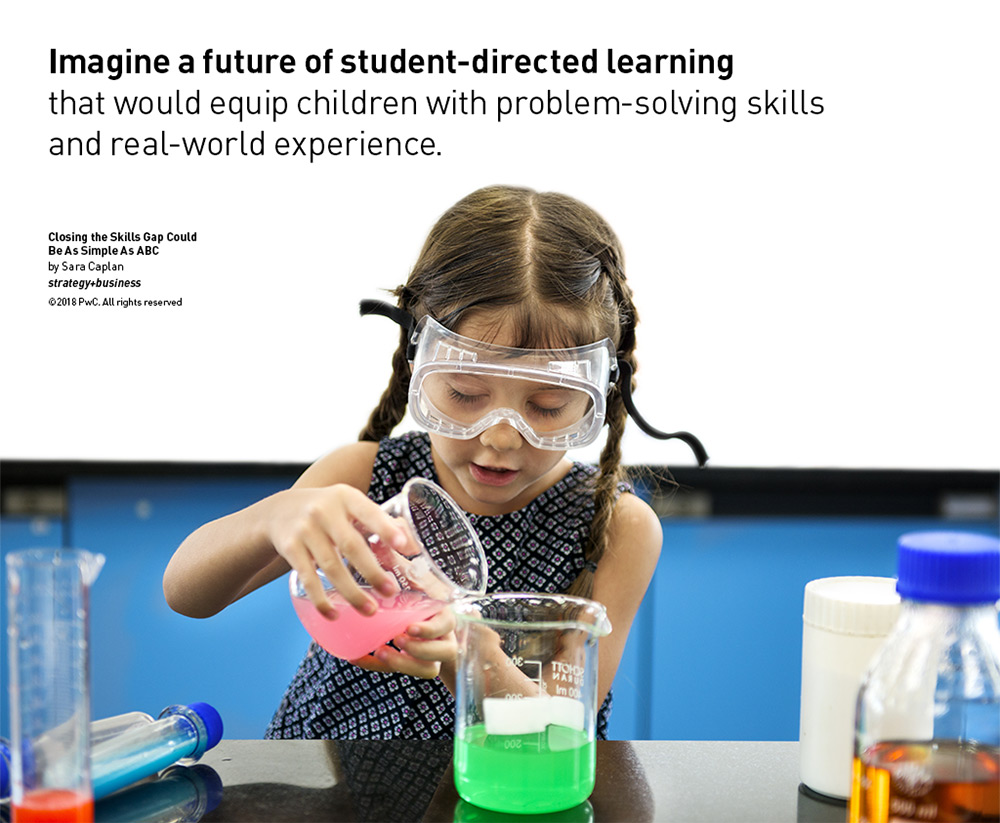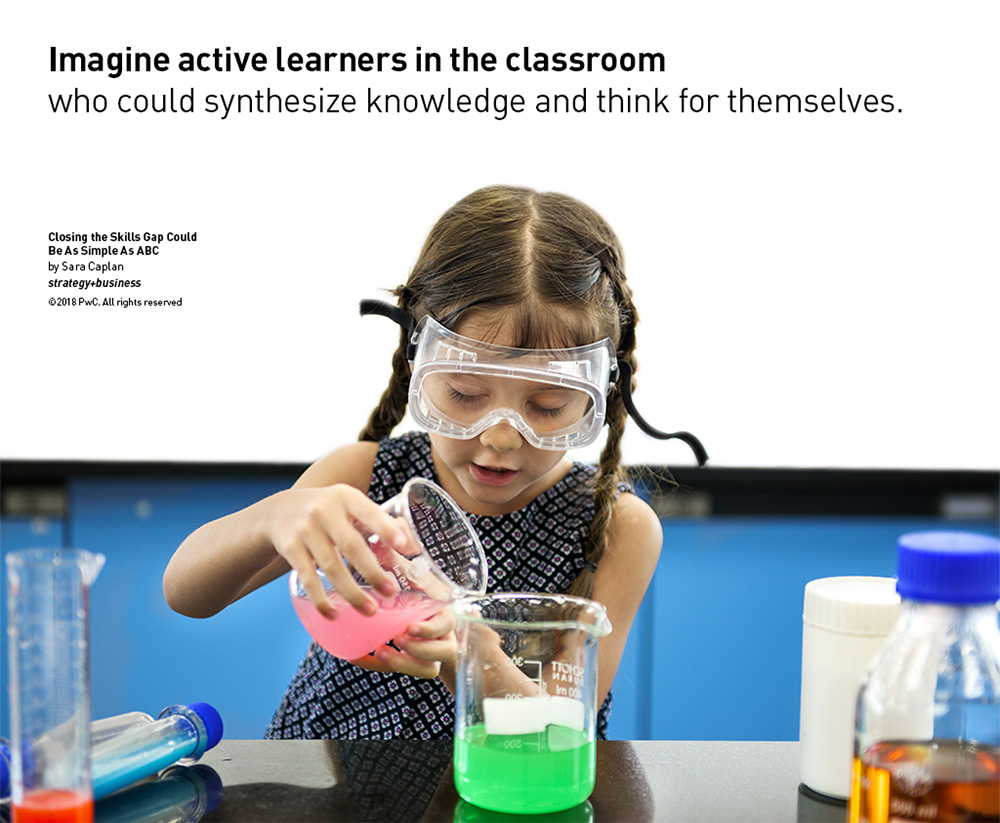Closing the Skills Gap Could Be as Simple as ABC
More collaboration between businesses and schools is vital to ensure that the next generation of workers is “future-fit.”
Note: This is the first post in a three-part series that explores how CEOs are responding to some of the key challenges raised in the PwC Global CEO Survey. Read the second post here and the third post here.
When I attended school in northeast England during the 1970s, individual learning was the order of the day. Separate workbooks, separate desks. Strictly no collaboration. And yet the content itself was generic for all students, right down to the teacher’s notes, which we copied judiciously off the blackboard and then learned by rote.
Nothing about our education was customized.
Fast-forward 40 years and, although the technology inside Western classrooms has changed, the style of teaching mostly hasn’t.
Today’s students still learn primarily via teacher instruction. Schools remain places of rigid hierarchies and didactic pedagogies. The curriculum is still dominated by standardized units, and schools are still required to stick to this curriculum for the sake of assessment.
Technology has made its way into the classroom in the form of laptops and tablets. Most schools now use learning apps for math and phonics, and children as young as 5 are learning to code. But scratch beneath the surface, and you’ll see that technology is predominantly being used to supplement the existing curriculum — a curriculum that is largely out-of-date.



Although education systems are struggling to leave the past, CEOs are looking toward the future. The picture they see, from a skills perspective, isn’t pretty. Under pressure to be strategic and adapt — quickly — to constant digital disruption, they’re worried that the workforce isn’t prepared. In PwC’s 21st CEO Survey, three in four CEOs expressed concern about the availability of key skills in today’s marketplace (75 percent of CEOs in Australia, and 79 percent globally), and more than half of all CEOs recognized they have a responsibility to reskill people in the face of automation (54 percent of CEOs in Australia, and 67 percent globally).
PwC’s Global CEO Survey: Providing unique insight into the thinking of corporate leaders around the world, PwC’s annual Global CEO Survey covers issues such as the prospects for economic growth, the challenges in building a workforce, the threats facing companies today, and the impact of AI.
Classrooms and core teaching methodologies need to evolve more quickly to keep up with the rate of change in the workplace. The current education system isn’t equipping students with the skills they need right now, let alone in the future. And CEOs are asking what can be done.
What many business leaders don’t realize is that they’re part of the answer.
Business Can Help Educators Find the “Why”
I began my working life in the education sector, as a lecturer in math and IT at Newcastle College in England. I loved math for math’s sake, and so it suited me to learn equations and trigonometry completely in isolation from any practical application.
Once I started teaching, however, I soon discovered that most people hate math. My students were plumbers, pipe fitters, and civil engineers. They didn’t want to consider the reflective properties of the parabola; they only wanted to know its practical applications and how multiplication and division would support them when they had to estimate job costs or calculate water pressure or structural forces.
So my task was more than teaching them math — it was putting their learning into context so they could see how they’d use it at work. I had to provide the “why” in their lessons.
This is precisely how business leaders can help shape the workforce of the future. Alongside educators, businesses need to build a pipeline from the classroom to the workplace so the skills taught today match the skills that’ll be in demand tomorrow. The key is for business leaders to understand how their organizations are going to change so they can proactively consider how to upskill their workforces accordingly. Envisioning this future state will soon be one of the most critical roles of the CEO.
Businesses need to build a pipeline from the classroom to the workplace so the skills taught today match the skills that’ll be in demand tomorrow.
The pipeline can take many forms. On a micro level, PwC Australia hosts the annual Schools Plus Conference, where head teachers have the opportunity to see PwC’s workplace and watch how people work. Every year, the feedback from teachers is overwhelmingly positive. It’s unsurprising when you consider that many teachers have little or no experience of working life outside of the classroom. And yet, I wonder how many CEOs stop to think about this fact, and about how simply getting a glimpse into a modern workplace can inform the way educators teach.
At the other end of the scale, business leaders can shape educational outcomes via initiatives such as Big Picture Education Australia. Big Picture is a nonprofit company with international partners in the U.S., U.K., China, India, Israel, Italy, Canada, and New Zealand that’s rethinking learning in secondary schools by providing personalized and project-based education. “Customization is at the heart of many recent changes to our society and economy,” says Big Picture CEO Viv White. “So at Big Picture we ask: Why not education, too?”
To this end, Big Picture teams up with employers to match students to workplaces they might be interested in, but not for conventional “work experience.” Big Picture students spend one or two days every week in the workplace, for up to several months or even years at a time. They also collaborate with real employees to implement solutions to real organizational problems.
In this way, employers become active partners with educators. CEOs have a say in what skills are being taught to address the current shortfall. And they are responsible for being part of the skills solution, too.
Imagine what the workforce might look like if this kind of education partnership were rolled out more broadly. Instead of the traditional, teacher-centric classrooms that I recall from my school days, we’d see student-directed learning in classrooms that mix conventional learning with workplace know-how and equip students with problem-solving skills and real-world experience. We’d have active learners who could synthesize knowledge and think for themselves. Students who could understand their role in a team, and collaborate successfully.
Just like employers and educators must.




